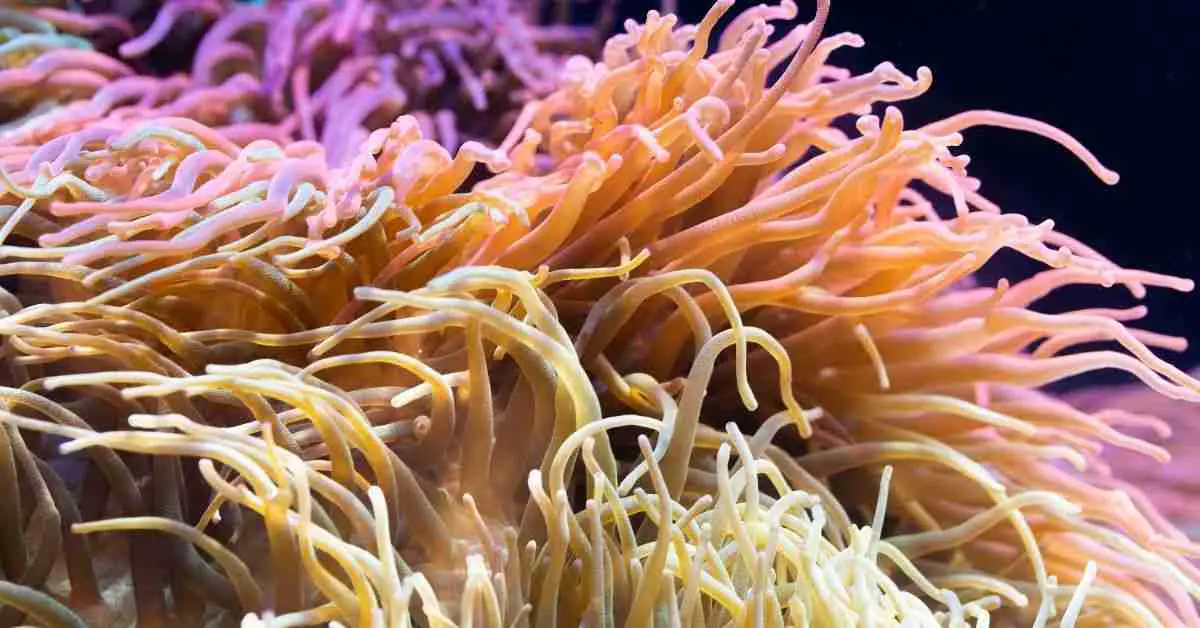One day, you notice changes in the appearance of your long tentacle anemone. That is, it’s showing symptoms of dying. Your first thought is how to save your beloved anemone.
Why is your long tentacle anemone dying?
Well, there are certain reasons which are making its health decline. The incorrect levels of water salinity, temperature, and lighting are possible reasons.
It might also not be getting the food it needs. Finally, the size and environment of your reef tank aren’t suitable for it.
However, prompt actions taken to fix the issues can certainly save your anemone!
We’ve listed 6 possible reasons leading to its death in this article. We’ll also explain how to save it in detail. So, stay tuned!
Symptoms of a Dying Long Tentacle Anemone
Certain symptoms shown by your long tentacle anemone give you a hint of their bad state. If you notice these changes, you can quickly take action to save its life.
The symptoms leading to the anemone’s life-threatening conditions usually are-
Change in Colour
If your anemone looks bleached or whitish, it’s a symptom of its declining health. This is a common yet dangerous symptom that needs immediate attention.
It’s not only anemones that show their bad condition through this color change. Corals like green star polyps also die if they’re not given treatment for this symptom too.
Disintegration of Skin
This is another scary symptom that is fairly common in corals and this anemone. That is, you’ll see that the skin of your anemone is disintegrating.
It mainly happens due to the nutrition deficiency of long tentacle anemones.
Rancid Smell
This is the most life-threatening symptom of them all. So, if you observe any of the other two symptoms above, check one more thing.
Take the long tentacle anemone out of the tank and smell it. If you get a rancid smell from it, it truly is dying.
Unfortunately, it might be close to impossible to save it as well.
Why Is My Long Tentacle Anemone Dying? ( How To Save It)
Let us first tell you that long tentacle anemones are extremely demanding. With full and expert care, they don’t survive in reef tanks for more than a month.
That’s why most recommend keeping these anemones only if the owner is experienced. So, you can now understand that bringing it back to its usual state may not be simple.
However, it’s not as if they keep dying like Elegance corals for their low survival rate.
So, if you’re fully dedicated to taking care of it, we got your back! Surely, we can save your long tentacle anemone from dying.
That’s why we have stated 6 reasons which will most likely lead them to death. Of course, that comes with the details of what you should do.
Reason 1 of 6: Small Tank
To meet the demands of your spoiled anemone, you must give it the perfect tank environment.
Many people have small reef tanks which the long tentacle anemone can’t adjust with
That’s because these creatures grow to a very large size. So, without the proper environment, their health declines.
Solution
It’s safe to say that a tank of 55 gallons is appropriate for long tentacle anemones. So, if your tank is of the size of 10 gallons or less, it’s most likely what’s causing bad symptoms.
Reason 2 of 6: Low Temperature
Low temperature is another issue with which these anemones have trouble adjusting. Because, as we’ve said before, they’re used to staying in warm water reefs.
So, it’s necessary to provide a temperature warm enough for them.
Solution
The recommended temperature of your reef tank should be around 78-79 degrees Fahrenheit.
So, check the temperature of your reef tank. If it’s too low, increase it to 78-79.
Your long tentacle anemone might revert to its usual state after this change.
Reason 3 of 6: Insufficient Lighting Conditions
Because of their demanding nature, the lighting should be adequate for the anemones.
Otherwise, they cannot photosynthesize properly, and malnutrition might lead to their death.
Solution
Usually, t5 bulbs are recommended for long tentacle anemones. T5 bulbs contribute to the growth and photosynthesis of these anemones and corals.
However, another alternative for suitable lighting for them is metal halides. They are cheap and easily available.
So, you have found the perfect thing to help to bring your anemones back safely to you.
Reason 4 of 6: Inadequate Food
You can understand that your anemone is suffering from malnutrition from one thing. That is their color slowly turning whitish.
This means that your long tentacle anemone is slowly losing its zooxanthellae.
Solution
To make it regain its zooxanthellae back, it needs meaty foods.
So, try feeding it small shrimps or other forms of meat, and the issue might be fixed! You can freely feed them these 2-4 times a week.
Reason 5 of 6: Incorrect Water Salinity
Finally, the wrong water salinity level in your reef tank causes their health to deteriorate.
After all, these anemones are used to staying in warm water reefs. So, they need a fixed and correct salinity level.
Solution
Many unknowingly keep the salinity level of water low in their reef tanks. But this won’t work in the case of long tentacle anemones.
For them, you must keep the salinity at least around 1.024-1.025. To increase the salinity of your tank water, siphon out 10% of the aquarium water.
Then gradually add saltwater there. As long as you maintain the salinity of your tank, you won’t face any issues.
Surely, the health of your beloved anemone will slowly improve.
Reason 6 of 6: Crowded Environment
As a demanding creature, the long tentacle anemone is aggressive and competitive. If you keep other long tentacle anemones in the same tank, chemical warfare might happen.
That is, as defense, they might change their physiology to compete with each other.
Solution
These changes they make for the competition can cause further decline in health.
So, try not to keep more than one of these anemones together in the same tank.
FAQs
Question: How can I tell if my long tentacle anemone is healthy?
Answer: You’ll see them firmly attached to the tank’s glass with their mouth closed.
It’s also a good sign if you see your anemone being expanded.
Question: How long does an anemone naturally live?
Answer: Anemones can survive for around 60-80 years in the sea. They do not age because of their cloning ability. So, they still are until they get attacked by predators.
Question: Can clownfish kill anemones?
Answer: Yes. Clownfish can kill anemones, so they shouldn’t be kept together. Anemones sting clownfish with their tentacles.
But they need to acclimate themselves before being immune from their own stings. If they don’t acclimate beforehand, they’ll die.
Conclusion
These are the ways you can efficiently keep your long tentacle anemone from dying.
One extra tip: As you know, these anemones need a lot of maintenance.
So, your tank should run for 6 months before you keep any long tentacle anemones there. They’re highly unlikely to survive new tanks.


